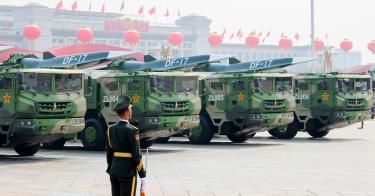In August, a Chinese civilian rocket shot through the atmosphere, a nuclear-capable hypersonic glide vehicle sitting atop. After circling the globe in low-Earth orbit, the rocket released its payload.
Upon reentering the Earth’s atmosphere, the glide vehicle was guided toward a ground target in China. The simulated strike was reportedly some 20 miles wide of the mark, but the test is largely seen as a success.
That’s not good news for us.
Indeed, Gen. Mark Milley, the chairman of the Joint Chiefs of Staff, equated the Chinese launch to a “near Sputnik moment”—a reference to the Soviet Union’s launch of the world’s first satellite into orbit in 1957.
>>> The United States Can Shape China’s Collapse
While Gen. Milley’s characterization might be a bit overly dramatic, the August test is without question a significant military milestone in our great power competition with the People’s Republic of China. And in this area of advanced weaponry, the U.S. is trailing.
Badly.
The United States hasn’t fielded a hypersonic weapon of any kind, meaning that China—our pacing threat—is developing a military capability that we don’t have. The implications of this development to our national security aren’t quite clear yet—but they’re not likely good.
Hypersonic weapons travel at speeds in excess of Mach 5, or roughly one mile per second. That’s super-fast—and as we know from military science: speed kills. Hypersonic weapons dramatically shorten a defender’s warning and response times.
These weapons are also maneuverable. Hypersonic boost-glide weapons and hypersonic cruise missiles can evade defenses and make it difficult for defenders to determine their final target.
Hypersonic weapons can be armed with either conventional or nuclear warheads. Moreover, they can use the high kinetic energy derived from their hypersonic speed to destroy a target. This gives the attacker great flexibility in adapting the payload to match a variety of tactical or strategic objectives.
Depending on the initial boost vehicle used, hypersonic weapons can be used for anything from short-range attacks to intercontinental-range attacks. Clearly, China‘s late summer test, which circumnavigated the globe, had intercontinental range—meaning no target is out of reach.
With potential flight paths extending through the atmosphere and into space, hypersonic weapons could be difficult to acquire and track due to a variety of limitations: physics, geography and the location of U.S. strategic radars and other available sensors.
Though not indefensible, hypersonic weapons do pose a tremendous challenge to our current U.S. defense systems, and potential American and allied targets vastly outnumber these limited defenses.
While August’s test was reportedly the first of a few Chinese trials pairing a hypersonic weapon with an intercontinental ballistic missile, it should be mentioned that the People’s Liberation Army already has an operational intermediate-range hypersonic weapon: a pairing of its DF-17 missile with a hypersonic glide vehicle.
This state of play is deeply unfortunate, especially considering that the U.S. led the world in hypersonic weapons research and development until 2014, when defense sequestration forced funding cuts.
>>> Pentagon’s China Military Power Report Confirms Beijing’s Nuclear Ambitions
While the Chinese now clearly lead us in hypersonic development, they may not have it for long—if we do the right thing.
Funding for hypersonic weapons R&D is now robust across all the services. The Army and Navy are set to begin fielding hypersonic glide weapons next year. Meanwhile, the Air Force and the Defense Advanced Research Projects Agency (DARPA) are working together to develop a scramjet-powered hypersonic cruise missile.
The United States could—and should—catch up with Chinese advances in hypersonic weapons in short order. It’s an important undertaking for both conventional and strategic stability in a time when there are growing questions about U.S. leadership in the world.
China‘s launch this summer may not be exactly a Sputnik moment, but it is definitely a hypersonic shot across the bow of the American ship of state.
This piece originally appeared in The Washington Times



